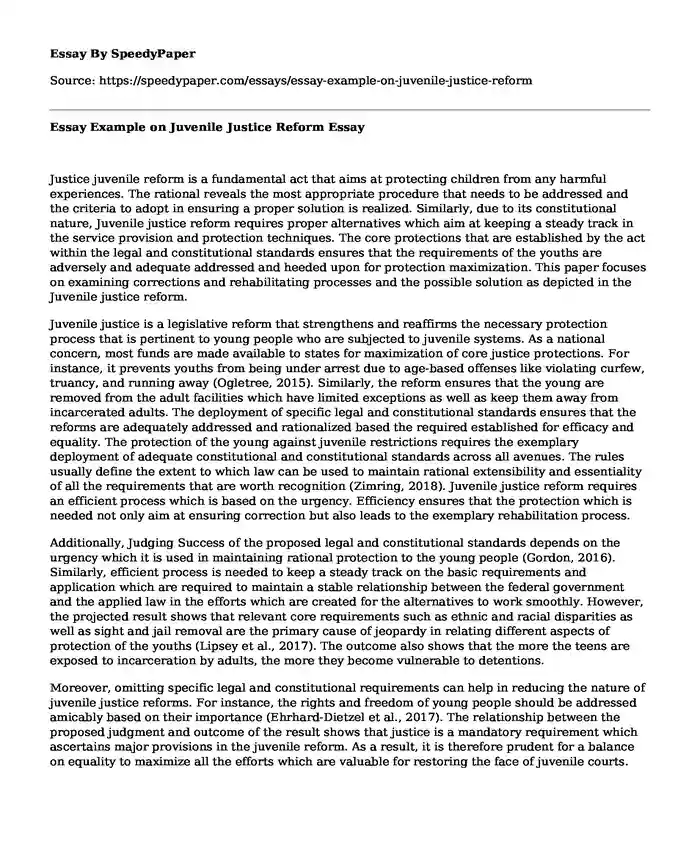
| Type of paper: | Essay |
| Categories: | Juvenile justice |
| Pages: | 3 |
| Wordcount: | 708 words |
Justice juvenile reform is a fundamental act that aims at protecting children from any harmful experiences. The rational reveals the most appropriate procedure that needs to be addressed and the criteria to adopt in ensuring a proper solution is realized. Similarly, due to its constitutional nature, Juvenile justice reform requires proper alternatives which aim at keeping a steady track in the service provision and protection techniques. The core protections that are established by the act within the legal and constitutional standards ensures that the requirements of the youths are adversely and adequate addressed and heeded upon for protection maximization. This paper focuses on examining corrections and rehabilitating processes and the possible solution as depicted in the Juvenile justice reform.
Juvenile justice is a legislative reform that strengthens and reaffirms the necessary protection process that is pertinent to young people who are subjected to juvenile systems. As a national concern, most funds are made available to states for maximization of core justice protections. For instance, it prevents youths from being under arrest due to age-based offenses like violating curfew, truancy, and running away (Ogletree, 2015). Similarly, the reform ensures that the young are removed from the adult facilities which have limited exceptions as well as keep them away from incarcerated adults. The deployment of specific legal and constitutional standards ensures that the reforms are adequately addressed and rationalized based the required established for efficacy and equality. The protection of the young against juvenile restrictions requires the exemplary deployment of adequate constitutional and constitutional standards across all avenues. The rules usually define the extent to which law can be used to maintain rational extensibility and essentiality of all the requirements that are worth recognition (Zimring, 2018). Juvenile justice reform requires an efficient process which is based on the urgency. Efficiency ensures that the protection which is needed not only aim at ensuring correction but also leads to the exemplary rehabilitation process.
Additionally, Judging Success of the proposed legal and constitutional standards depends on the urgency which it is used in maintaining rational protection to the young people (Gordon, 2016). Similarly, efficient process is needed to keep a steady track on the basic requirements and application which are required to maintain a stable relationship between the federal government and the applied law in the efforts which are created for the alternatives to work smoothly. However, the projected result shows that relevant core requirements such as ethnic and racial disparities as well as sight and jail removal are the primary cause of jeopardy in relating different aspects of protection of the youths (Lipsey et al., 2017). The outcome also shows that the more the teens are exposed to incarceration by adults, the more they become vulnerable to detentions.
Moreover, omitting specific legal and constitutional requirements can help in reducing the nature of juvenile justice reforms. For instance, the rights and freedom of young people should be addressed amicably based on their importance (Ehrhard-Dietzel et al., 2017). The relationship between the proposed judgment and outcome of the result shows that justice is a mandatory requirement which ascertains major provisions in the juvenile reform. As a result, it is therefore prudent for a balance on equality to maximize all the efforts which are valuable for restoring the face of juvenile courts.
Conclusion
In conclusion, the federal government needs to increase accountability as well as improves the educational services and conditions for the youths. The law should focus on specific basic needs, which are pertinent for the teenagers within their population. Overall, the elimination of many forms of dangerous practices in confinement such as restraint on pregnant girls should be deployed to reduce incidences of unplanned births due to stress.
References
Lipsey, M. W., Conly, C. H., Chapman, G., & Bilchik, S. (2017). Juvenile justice system improvement: Implementing an evidence-based decision-making platform. Center for Juvenile Justice Reform, Georgetown University.
Gordon, S. A., (2016). Juvenile Justice Reform in Texas: The Context, Content & Consequences of Senate Bill 1630. J. Legis., 42, 232.
Ehrhard-Dietzel, S., Barton, M. S., & Hickey, D. A. (2017). Implementation and outcomes of an innovative front end juvenile justice reform initiative. Child and Adolescent Social Work Journal, 34(3), 223-234.
Ogletree Jr, C. J. (2015). A new juvenile justice system: Total reform for a broken system. NYU Press.
Zimring, F. E., (2018). American juvenile justice. Oxford University Press.
Cite this page
Essay Example on Juvenile Justice Reform. (2023, Jan 13). Retrieved from https://speedypaper.net/essays/essay-example-on-juvenile-justice-reform
Request Removal
If you are the original author of this essay and no longer wish to have it published on the SpeedyPaper website, please click below to request its removal:
- Free Essay on Faculty Use and Perceptions of a Course Management System
- My Own Human Strength - Personal Essay Example
- Crisis Management and Disaster Preparedness Essay Sample
- Gender Roles in Moll Flanders by Daniel Defoe
- Paper Example on Cancer Patients Living With Diabetes
- Free Essay on Catholic Mass Versus Christian Church Service
- Free Essay Example. Cash Flow in the Nonprofit Business Model
Popular categories




